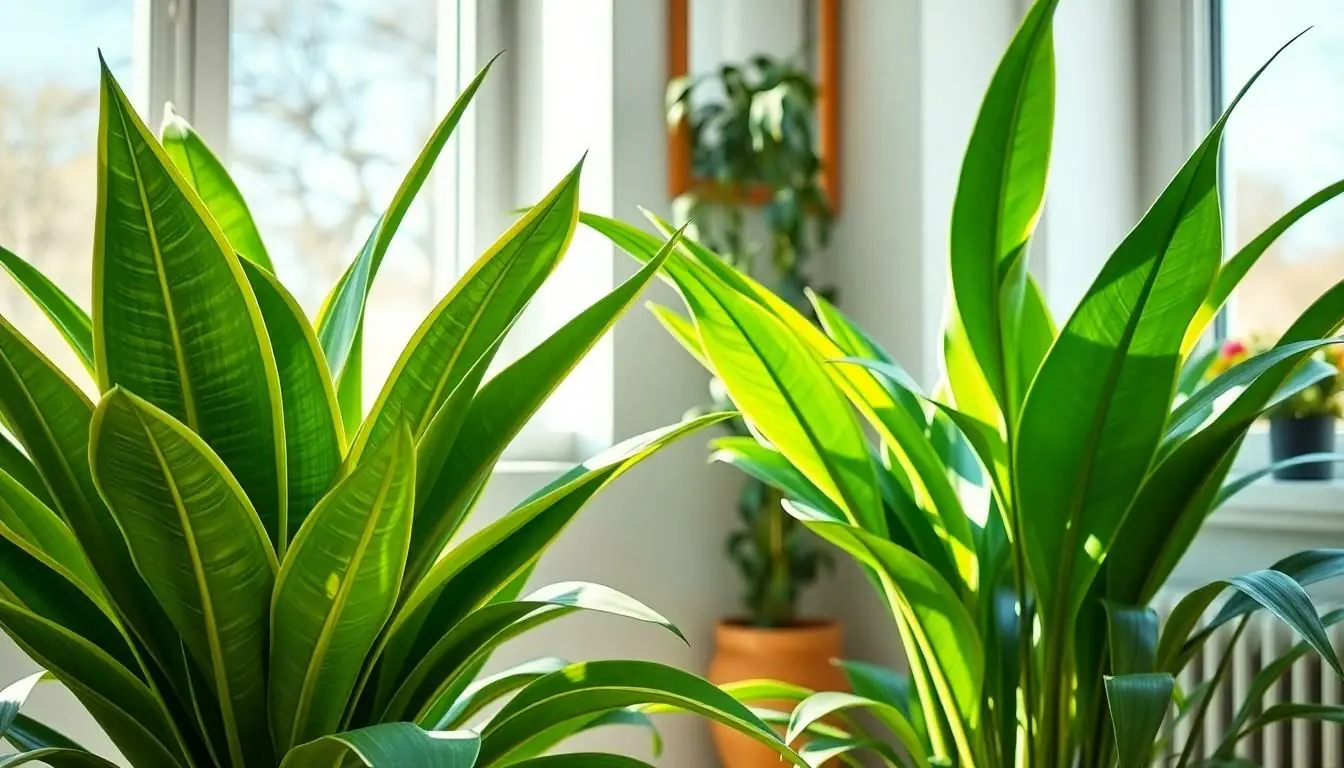Table of Contents
ToggleBringing a slice of nature indoors can transform any space, but what if your home has all the charm of a cave? Fear not! Large house plants that thrive in low light are here to save the day (and your sanity). These leafy giants not only purify the air but also make your home feel vibrant and alive, even if your windows are more like tiny peepholes.
Overview of Large House Plants
Large house plants create a significant visual impact while thriving in low light conditions. They offer an ideal solution for spaces that lack sufficient sunlight. Common varieties include the Snake Plant, ZZ Plant, and Pothos, which are known for their resilience. Each plant features unique characteristics that contribute to indoor aesthetics and air quality.
Snake Plants can tolerate neglect, requiring minimal watering and low light. Their tall, upright leaves add structure to any room. ZZ Plants, with glossy leaves, also adapt well to dim environments. This makes them suitable for offices or shaded corners.
Pothos offers versatility, as it can be both a trailing and climbing plant. Plants can grow in a range of containers, allowing for various display options. High humidity enhances their growth, yet they remain resilient through dry spells.
Understanding the specific needs of these large house plants ensures better care and longevity. Low light does not hinder their growth; rather, it allows them to thrive with proper attention. Indoor gardeners appreciate these plants for their forgiving nature and hardiness.
Choosing large house plants that require little light not only beautifies spaces but also promotes sustainable living. Each selection contributes to a healthier environment by improving air quality through photosynthesis. Incorporating these plants into home decor transforms dull areas into vibrant habitats.
Benefits of Low Light Plants

Low light plants offer numerous advantages for indoor environments, especially in areas with limited natural light. Integrating these plants enhances air quality and contributes to an inviting ambiance.
Air Quality Improvement
Low light plants, such as Snake Plants and ZZ Plants, play a significant role in improving indoor air quality. These plants absorb toxins like formaldehyde and benzene, filtering the air. They contribute to a healthier living environment by releasing oxygen, especially at night. Moreover, a study by NASA highlights the air-purifying abilities of various houseplants. Increased humidity levels from transpiration also benefit overall respiratory health. Incorporating these plants into indoor spaces helps create a fresher atmosphere, essential for well-being.
Aesthetic Appeal
Large house plants excel in enhancing the aesthetic appeal of interiors. They create a focal point in rooms, adding texture and depth. Options like Pothos provide versatility, whether trailing from a shelf or climbing a trellis. Different leaf shapes and colors offer visual interest, complementing various decor styles. Eye-catching plants like the Snake Plant add architectural elements with their upright leaves. By improving the ambiance, these plants encourage relaxation and boost mood, transforming dull spaces into vibrant places.
Best Large House Plants for Low Light
Large house plants that thrive in low light create lively indoor environments. They purify air while improving aesthetics, making them ideal for dimly lit spaces.
Snake Plant
Snake plants excel in low light conditions. Their stiff, upright leaves add a striking architectural element to any room. Minimal care is required, making them perfect for busy individuals. This resilient plant tolerates infrequent watering and responds well to neglect. As an air purifier, it filters toxins such as formaldehyde and benzene, contributing to healthier indoor air quality.
ZZ Plant
ZZ plants flourish in low light, making them suitable for dark corners. Their glossy leaves capture attention, showcasing a unique, polished appearance. This plant adapts effortlessly to varying humidity levels, thriving even where other plants may struggle. An infrequent watering schedule suffices for its survival. Additionally, ZZ plants improve air quality by removing harmful pollutants, enhancing the overall well-being of indoor spaces.
Pothos
Pothos provides versatility through its climbing or trailing growth habit. This large house plant stands out with its heart-shaped leaves, available in various colors. It thrives effortlessly in low light environments, surviving even in low-maintenance settings. A simple watering routine ensures its vitality. Pothos acts as an air purifier, absorbing toxins and releasing oxygen, thus making spaces feel fresher and more inviting.
Peace Lily
Peace lilies thrive in low light settings, exhibiting elegant white blooms against lush green foliage. Their graceful appearance enhances interior decor significantly. Peace lilies enjoy slightly moist soil, requiring consistent but not excessive watering. This plant also purifies air by filtering harmful substances like ammonia and benzene. For those who seek a low-light solution, peace lilies combine beauty and functionality in one striking package.
Care Tips for Low Light Plants
Caring for low light plants enhances their growth and longevity. Proper attention to watering and soil mix significantly impacts plant health.
Watering Guidelines
Watering requires a delicate balance for low light plants. Overwatering leads to root rot, while underwatering can cause stress. Checking the top inch of soil helps gauge moisture levels; if it’s dry, it’s time to water. Snake Plants thrive on infrequent watering, often needing water only every two to three weeks. ZZ Plants prefer drier conditions, so allowing the soil to dry out completely between waterings benefits their growth. Pothos enjoys a slightly moister environment and requires watering once a week. Monitoring each plant’s unique needs ensures happy and healthy growth.
Ideal Soil Mix
Selecting the right soil mix is crucial for low light plants. A well-draining potting mix suits most varieties, providing the necessary aeration and moisture retention. For Snake Plants, a cactus or succulent mix works well due to its drainage properties. ZZ Plants benefit from an all-purpose mix combined with perlite to enhance aeration and drainage. Pothos thrives in standard potting soil, enriched with organic matter to promote healthy growth. Regularly checking soil pH helps maintain an optimal environment, ideally ranging from 6.0 to 7.0 for most low light plants.
Common Issues and Solutions
Large house plants in low light conditions may encounter specific problems. Understanding these challenges helps maintain their health and vitality.
Overwatering presents a significant risk. Excess water can lead to root rot. To avoid this, ensure pots have drainage holes and allow the soil to dry out before the next watering. For example, a Snake Plant thrives when watered every two to three weeks.
Underwatering can also cause stress. When plants lack moisture, leaves may wilt or turn brown. A ZZ Plant prefers thorough watering but should dry out completely between sessions. Regular checking of soil moisture levels aids in preventing dehydration.
Low light levels might inhibit growth. While these plants can thrive in dim conditions, insufficient light can lead to leggy growth. Consider moving them to brighter spots for part of the day. A Pothos can tolerate low light but appreciates indirect sunlight.
Pests such as spider mites and mealybugs may invade plants, especially in stagnant conditions. Regularly inspecting plants and wiping leaves helps prevent infestations. Neem oil can provide a safe treatment option for addressing pest problems.
Nutrient deficiency can occur over time. A well-balanced fertilizer during the growing season supports healthy growth. Opt for a diluted liquid fertilizer every four to six weeks to replenish essential nutrients.
Leaf yellowing can signal various issues. This may result from overwatering, inadequate light, or nutrient deficiencies. Monitoring conditions closely allows for timely corrective measures.
By recognizing these common issues and applying appropriate solutions, the health of large house plants in low light environments improves significantly.
Incorporating large house plants that thrive in low light can transform any indoor space into a vibrant oasis. These resilient plants not only enhance the aesthetic appeal of a home but also contribute to improved air quality. Choosing varieties like Snake Plants, ZZ Plants, Pothos, and Peace Lilies ensures that even the dimmest corners of a home can flourish.
With proper care and attention to watering and soil conditions, these plants can thrive and provide a sense of tranquility. Embracing low light house plants is an excellent way to bring nature indoors, creating a refreshing environment that promotes well-being and relaxation.




